Creating Your Brand Voice: A Complete Guide
Your personality makes you unique — a differentiation that doesn’t just apply to people. Brand voices will make each company recognizable in a world full of different streams of information. So how can you set your brand up for success?
A powerful brand voice that can not go unnoticed, because it is strong enough to make people pay attention. This post explores the elements that create a brand’s voice. You’ll also learn how you can create your brand voice and examples that can inspire your team.
Table of Contents
- What is a brand voice?
- Creating a Brand Voice
- Brand Voice Examples
- Brand Voice Template
- Crafting Your Voice
Your brand voice should be uniform across platforms. According to Crowdspring, 90% of potential customers expect to have a similar brand experience across different platforms. Your company should sound the same on social media, in email communications, and even on packaging.
Further, your company’s voice should resonate with your audience and be used to build trust. In the U.S. market, 46% of consumers prefer to buy from brands that they can trust.
Your brand voice should build that trusting relationship, showing your customers what to expect from your company’s content, services, and even customer service.
Plus, the right approach can help attract new prospects before they even learn about your product or services. For instance, consider the humor used in MoonPie’s social media posts.
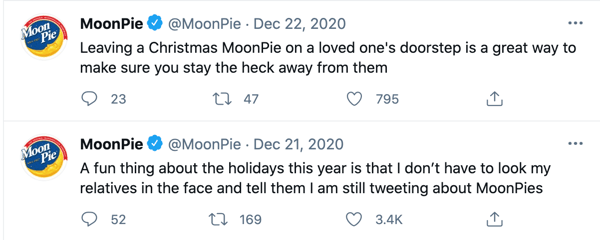
Before I’d even purchased a MoonPie for the first time, I followed them on Twitter. Why? Because I liked the brand’s voice. Their tweets made me laugh and felt relatable.
However, a brand voice doesn’t have to be funny to be powerful. Other powerful brand voices can be inspiring, emotional, bold, casual, formal, poetic, or direct.
Creating a Brand Voice
How do you know if your brand voice is working? If a potential customer feels like you’re talking directly to them, then you’re doing it right.
When your customers feel like they’re part of the conversation, they feel more connected to the brand and are more likely to buy from you.
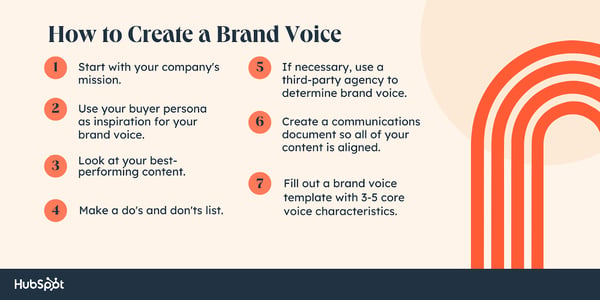
See more tips for building your brand’s voice below.
1. Start with your company’s mission.
Your brand’s mission or value statement can help you determine some key characteristics of your brand voice.
For instance, consider A Good Company’s values page:
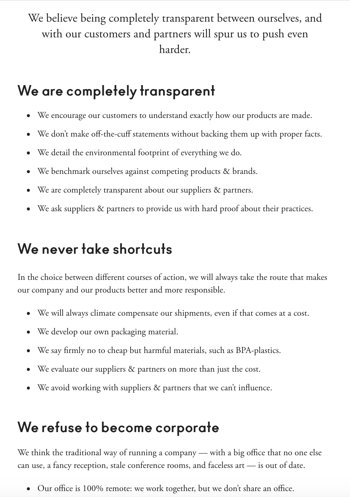
You’ll see these values — transparency, eco-friendliness, and modern instead of traditional — embedded in every piece of content you read from A Good Company.
Now, let’s check the following post:
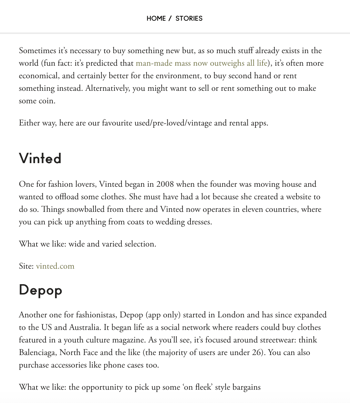
The writing is clear, straightforward, and direct to support the brand’s transparency values. The writer takes the angle of eco-friendliness in the opinions expressed throughout the piece (i.e., “so much stuff already exists in the world”).
And, finally, there’s a casual, informal tone to the voice, hinting at a company that isn’t old-school and doesn’t take itself too seriously (i.e., “pick up some ‘on fleek’ style bargains”).
You’ll want to consider your own values when creating a brand voice. Those values can become key characteristics of your voice.
2. Use your buyer persona as inspiration for your brand voice.
When creating a brand voice, then, it’s vital you consider your buyer persona. Who are you trying to reach? What do they need from your brand? What can your brand offer them that no one else can,
Audience research can help you determine other types of content that perform best with your audience, which is undeniably helpful when creating a strong voice. For instance, perhaps you could survey your audience or use an analytics tool like Google Analytics to determine other sites your readers frequent.
Figuring out what else they consume is helpful here — your voice should be different if your readers often consume Buzzfeed content versus the New York Times. The Buzzfeed audience might prefer more casual, funny writing, while the latter probably likes more academic-style content.
Your audience will be the ultimate test of whether you’ve created a successful brand voice. If your voice doesn’t resonate with your audience, keep experimenting.
3. Look at your best-performing content.
If you’ve already been publishing content for a few months or even years, then take a look at your top-performing pieces and write down key characteristics of the voice used in your writing.
Is your top-performing piece more poetic? Does it include trends and pop-culture references? Does it dive deep into a topic and include original research to back up its claims?
Ultimately, these pieces are already resonating with your audience, and it’s likely (at least in part) due to voice. Take note of which aspects of the voice you feel can, and should, be replicated across your brand as a whole.
Also, you need to do some research about which content formats are best for your industry and how you can align that with your brand’s voice.
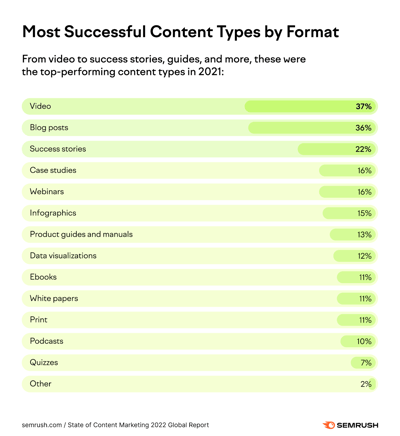
4. Make a do’s and don’ts list.
Oftentimes, determining brand voice starts by asking: “What don’t we want our brand voice to be?”
Figuring out what you don’t want your brand voice to be is a critical step in choosing the right voice for your brand.
For instance, perhaps your team brainstorms the following statements:
- Our brand voice is not pretentious.
- Our brand voice is not too serious.
- Our brand voice is not grandiose.
- Our brand voice is not unfriendly.
Once you’ve taken a look at these statements, you can begin forming the antithesis. For example, if your don’t list looks like the one above, your brand voice may follow the ethos below.
- Our brand voice is down-to-earth and authentic. It’s funny and casual. It’s humble. And it’s helpful.
5. If necessary, use a third-party agency to determine brand voice.
Forbes’ BrandVoice is a media partnership program that helps brands reach and resonate with their audiences through expert consultancy and direct access to Forbes audiences.
Take a look at how Cole Haan worked with Forbes to create content related to style, arts, travel, social impact, and more. Each piece uses a unique voice to target the intended audience for that category.
If you’re struggling to create a unique brand voice or you don’t know how to adapt your vision to the different areas of your business, consider using a program like BrandVoice or a third-party content marketing agency. This will help you take your brand’s game to the next level.
6. Create a communications document so all of your content is aligned.
Once you’ve created your brand voice, you’ll want to ensure your entire company can use that voice in all marketing materials.
If your company only uses internal writers, consider creating a training course for new staff so they can learn how to write for your brand. If you work with external guest contributors, you’ll want to make public-facing guidelines to ensure all your writing captures the appropriate voice.
7. Fill out a brand voice template with 3-5 core voice characteristics.
Use a table to formalize your process. Write down the 3-5 core characteristics you’ve determined are important for your brand’s voice and how your writers can use these traits in their writing.
This step is important for translating ideas into action — how can your writers create a “humble, authentic voice” in their writing? Give some examples or tactical advice to make it easy for your brand voice to come through in all of your content, regardless of byline.
To explore what a template could look like in practice, take a look at the brand voice template below.
Brand Voice Examples
Before you start crafting your unique voice, turn to role models who have perfected their tone. Here are five examples to get you started. You can see other distinct brand voices in the video below.
1. Spotify
Whether you’re watching a TV ad, driving past a billboard, or scrolling Spotify’s social accounts, you’ll see a consistent voice. The brand’s tone is consistently funny, edgy, direct, and concise.
For instance, take a look at this video, which is part of a Spotify advertisement campaign from 2019, “Let the Song Play.”
As you can see, Spotify doesn’t take itself too seriously. The ad makes fun of people who get so emotionally invested in a song that they won’t resume their plans until the song ends.
You’ll see a similar brand voice play out on Spotify’s social channels. On its Twitter account, for instance, the brand often posts tweets related to new music in a casual, friendly manner.
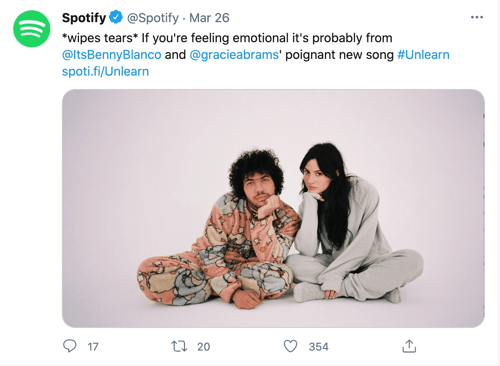
If Spotify’s brand were a person, she would be witty, sarcastic, and up-to-date on today’s pop culture references. You’ll see that personality play out across all of Spotify’s communication channels.
2. Mailchimp
When exploring Mailchimp’s brand voice, turn to the company’s Content Style Guide.
In the Style Guide, Mailchimp writes, “We want to educate people without patronizing or confusing them. Using offbeat humor and a conversational voice, we play with language to bring joy to their work.… We don’t take ourselves too seriously.”
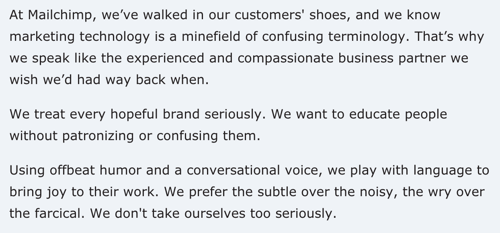
Even in the Style Guide, you can hear Mailchimp’s brand voice shine through. The company consistently achieves a conversational, direct, playful voice in all its content.
For instance, in this blog post, the brand writes about various “highly unscientific personas”, including the fainting goat. The email service provider describes this persona by saying, “when startled, its muscles stiffen up and it falls right over.” They then link out to this hilarious video.
As you can see from this example, you can evoke brand voice in subtle yet effective ways. If the blogger had instead written, “If a goat is scared, it becomes nervous. The animal’s muscles contract and it faints as a result”, the writer would’ve evoked a voice more aligned with a scientific journal than Mailchimp.
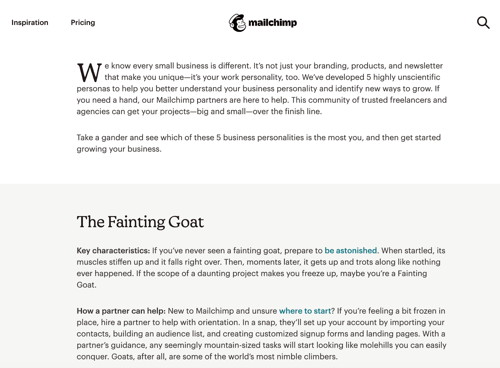
3. Fenty Beauty
The About Us page for Rihanna’s beauty company reads, “Before she was BadGalRiRi: music, fashion and beauty icon, Robyn Rihanna Fenty was a little girl in Barbados transfixed by her mother’s lipstick. The first time she experienced makeup for herself, she never looked back. Makeup became her weapon of choice for self-expression.”
It’s clear, even just through this short snippet, that Fenty Beauty’s voice is bold, direct, and poetic. Language like “transfixed by her mother’s lipstick” and “her weapon of choice for self-expression” reinforce this voice. However, the tone is also undeniably casual — the way you might talk to your best friend.
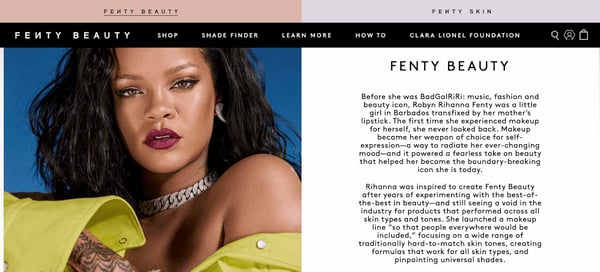
You’ll see this voice play out across all Fenty social channels, including this YouTube video description:
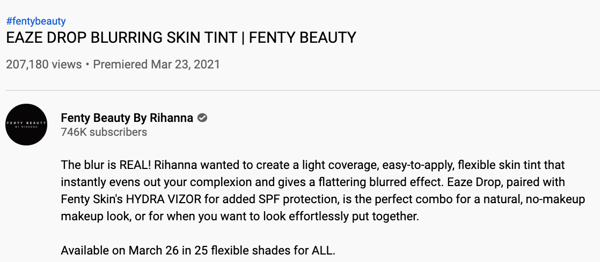
The first statement, “The blur is REAL!” — along with phrases like “No-makeup makeup look”, and the shortening of the word “combination” — all evoke a sense of friendliness.
The brand voice matches its target audience perfectly: youthful millennials and Gen-Zers who care about makeup as an opportunity for authentic expression.
4. Clare Paint
Clare, an online paint site, has created a mature, spirited, and cheerful brand voice to evoke a breezy, girl-next-door feel to their branded content.
For instance, consider the title of one of their recent blog posts, “6 Stylish Rooms on Instagram That Make a Strong Case For Pink Walls.”
The post uses phrases like “millennial pink”, “pink walls have obvious staying power”, and “designers and DIY enthusiasts alike have embraced the playful shade with open arms.” The brand’s language is friendly, chic, and professional, relating to its readers while simultaneously demonstrating the brand’s home decor expertise.
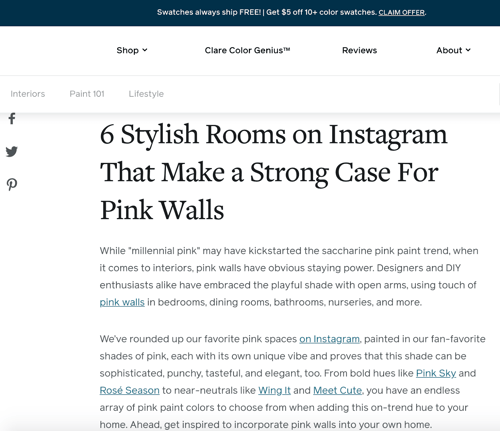
This voice is clear across channels. Take a look at this Instagram post, for instance.
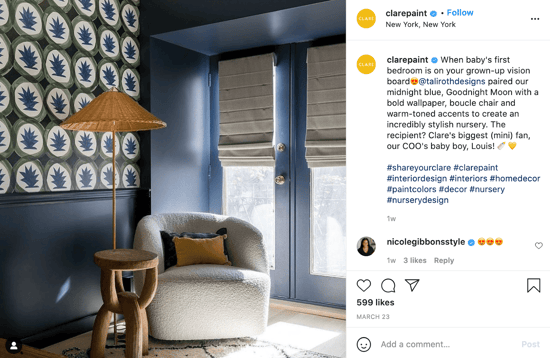
“When baby’s first bedroom is on your grown-up vision board” makes the brand feel like a good-natured older (and more fashionable) sister. The reference to the COO’s baby boy is another opportunity to make authentic connections with Clare’s followers.
5. Skittles
Skittles often posts hilarious social media posts that strip away any promotional, phony language so you’re left with something much more real.
Take a recent tweet, for instance, that reads: “Vote Skittles for Best Brand on Twitter so we can keep our jobs!”
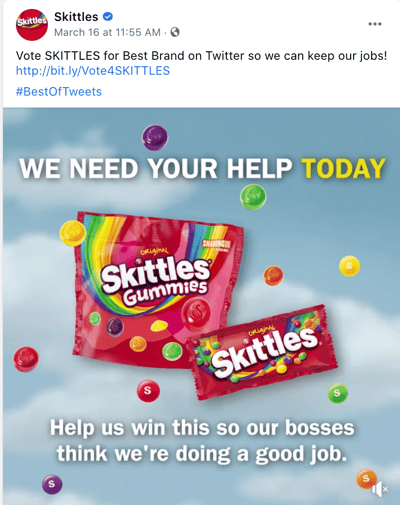
The brand voice, which is clever and original, does a good job of making prospects and customers feel like they’re chatting with a mischievous employee behind-the-scenes. The “I can’t believe they just posted that” factor keeps the content fresh and exciting.
Plus, the brand does a good job making pop culture references, like this Mean Girls reference, to highlight the brand’s youthfulness.
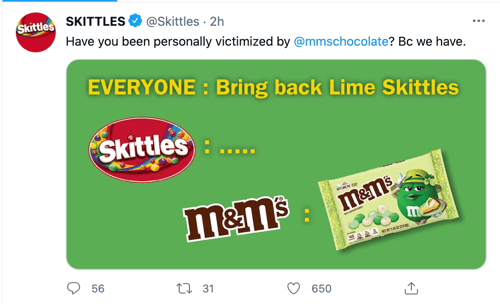
Skittles’ use of absurdity and humor plays into their iconic commercials. In one 2022 ad, the company pokes fun at targeted ads.
While two people watch a youtube video, they comment that their ads are so targeted that it feels as if Skittles is listening in on their conversation. Then, a man with a boom mike drops through the floor.
Skittles expertly keeps the same tone across media, showing their brand’s commitment to their voice.
Brand Voice Template
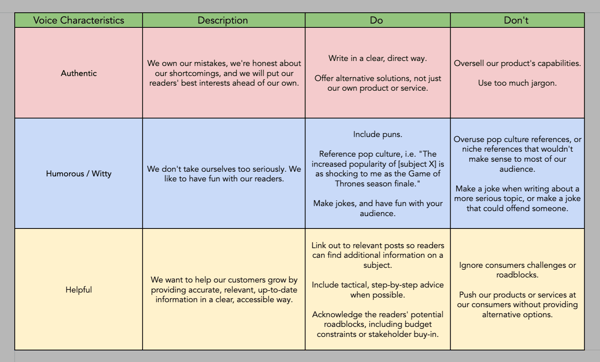
Looking to make a template for your own brand voice? HubSpot is here to help! You can fill out this blank Google Sheet template with your own brand voice characteristics. Then, fill out the remaining cells, and send them along to your team.
Collaborative, you’ll be able to create a unique brand voice to help your company stand out.
It’s important to note, you’ll be prompted to make a Google Drive copy of the template, which isn’t possible without a Google account.
Crafting Your Voice
And there you have it! You’re well on your way toward building a strong, compelling brand voice for your own business.
Remember: A good brand starts with good content. And good content can’t exist without a strong voice.
Editor’s Note: This post was originally published in April 2021 and has been updated for comprehensiveness.
![]()



